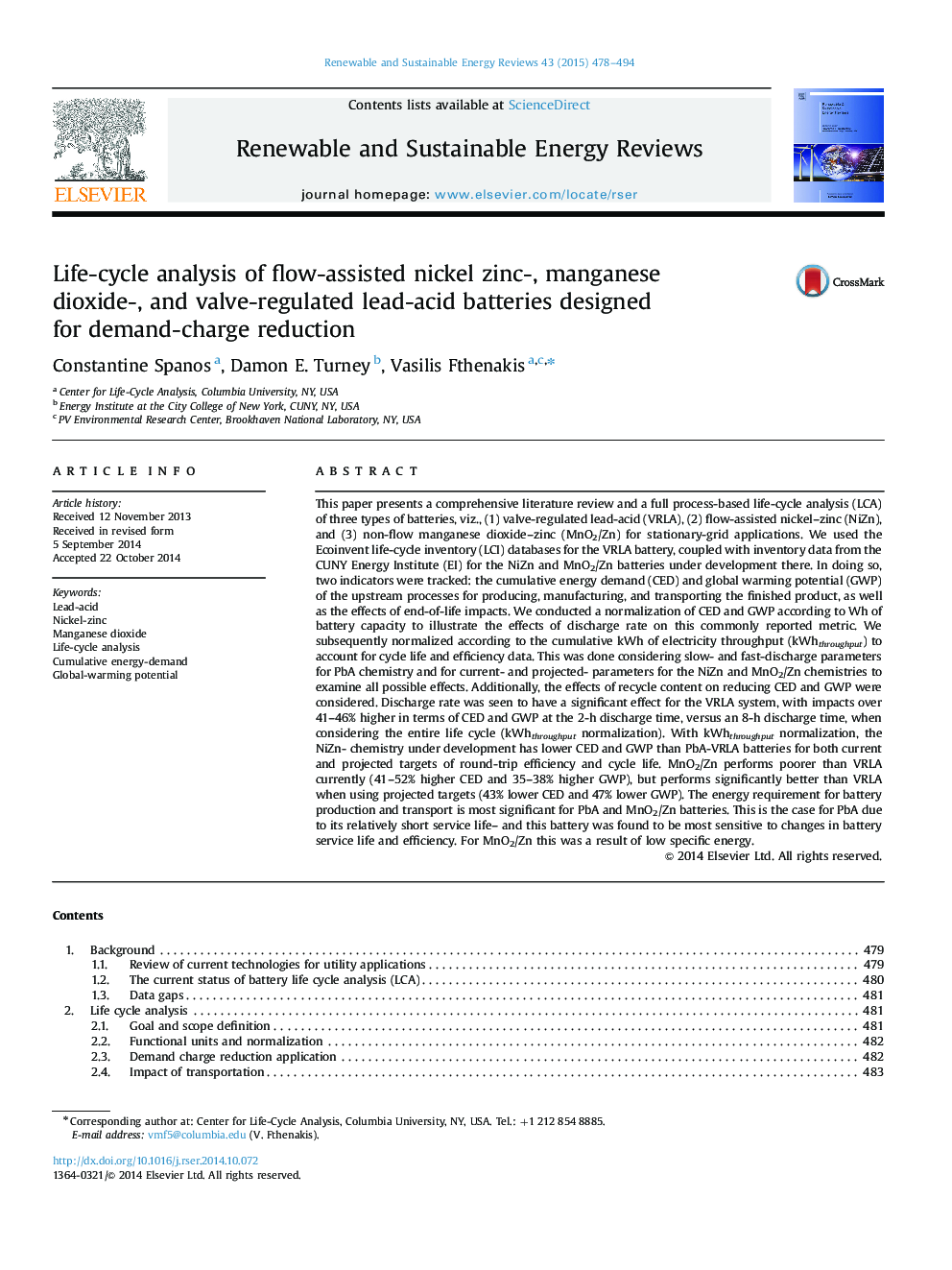| کد مقاله | کد نشریه | سال انتشار | مقاله انگلیسی | نسخه تمام متن |
|---|---|---|---|---|
| 8117695 | 1522342 | 2015 | 17 صفحه PDF | دانلود رایگان |
عنوان انگلیسی مقاله ISI
Life-cycle analysis of flow-assisted nickel zinc-, manganese dioxide-, and valve-regulated lead-acid batteries designed for demand-charge reduction
ترجمه فارسی عنوان
تجزیه و تحلیل چرخه عمر باتری های سرب اسید رشته ای نیکل روی، دی اکسید منگنز و دریچه، طراحی شده برای کاهش هزینه تقاضا
دانلود مقاله + سفارش ترجمه
دانلود مقاله ISI انگلیسی
رایگان برای ایرانیان
کلمات کلیدی
اسید سرب، نیکل روی، دی اکسید منگنز، تجزیه و تحلیل چرخه عمر، تقاضای انرژی تجمعی، پتانسیل گرمایش جهانی،
موضوعات مرتبط
مهندسی و علوم پایه
مهندسی انرژی
انرژی های تجدید پذیر، توسعه پایدار و محیط زیست
چکیده انگلیسی
This paper presents a comprehensive literature review and a full process-based life-cycle analysis (LCA) of three types of batteries, viz., (1) valve-regulated lead-acid (VRLA), (2) flow-assisted nickel-zinc (NiZn), and (3) non-flow manganese dioxide-zinc (MnO2/Zn) for stationary-grid applications. We used the Ecoinvent life-cycle inventory (LCI) databases for the VRLA battery, coupled with inventory data from the CUNY Energy Institute (EI) for the NiZn and MnO2/Zn batteries under development there. In doing so, two indicators were tracked: the cumulative energy demand (CED) and global warming potential (GWP) of the upstream processes for producing, manufacturing, and transporting the finished product, as well as the effects of end-of-life impacts. We conducted a normalization of CED and GWP according to Wh of battery capacity to illustrate the effects of discharge rate on this commonly reported metric. We subsequently normalized according to the cumulative kWh of electricity throughput (kWhthroughput) to account for cycle life and efficiency data. This was done considering slow- and fast-discharge parameters for PbA chemistry and for current- and projected- parameters for the NiZn and MnO2/Zn chemistries to examine all possible effects. Additionally, the effects of recycle content on reducing CED and GWP were considered. Discharge rate was seen to have a significant effect for the VRLA system, with impacts over 41-46% higher in terms of CED and GWP at the 2-h discharge time, versus an 8-h discharge time, when considering the entire life cycle (kWhthroughput normalization). With kWhthroughput normalization, the NiZn- chemistry under development has lower CED and GWP than PbA-VRLA batteries for both current and projected targets of round-trip efficiency and cycle life. MnO2/Zn performs poorer than VRLA currently (41-52% higher CED and 35-38% higher GWP), but performs significantly better than VRLA when using projected targets (43% lower CED and 47% lower GWP). The energy requirement for battery production and transport is most significant for PbA and MnO2/Zn batteries. This is the case for PbA due to its relatively short service life- and this battery was found to be most sensitive to changes in battery service life and efficiency. For MnO2/Zn this was a result of low specific energy.
ناشر
Database: Elsevier - ScienceDirect (ساینس دایرکت)
Journal: Renewable and Sustainable Energy Reviews - Volume 43, March 2015, Pages 478-494
Journal: Renewable and Sustainable Energy Reviews - Volume 43, March 2015, Pages 478-494
نویسندگان
Constantine Spanos, Damon E. Turney, Vasilis Fthenakis,
